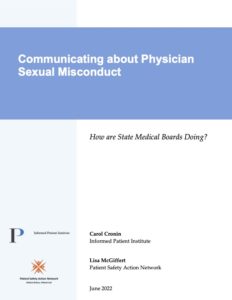Medical board websites fail to highlight—and often bury—information on physician sexual misconduct
 Medical boards’ website information about physicians’ sexual misconduct is often hard to find, euphemistic, and insufficiently condemning of misconduct, the Informed Patient Institute and the Patient Safety Action Network said in a highly critical June 15 report.
Medical boards’ website information about physicians’ sexual misconduct is often hard to find, euphemistic, and insufficiently condemning of misconduct, the Informed Patient Institute and the Patient Safety Action Network said in a highly critical June 15 report.
While praising the efforts of a few medical boards to provide accurate and accessible information, the report, “Communicating about Sexual Misconduct: How Are State Medical Boards Doing?” found that boards typically fall below par.
“Boards buried information for the public and for physicians on their websites in outdated policy papers, confusing statements about board attitudes or by referring readers to difficult-to read laws or regulations,” the authors noted. In place of clear messaging, references to “boundary issues” and “unprofessional conduct” were common. But in fact, the report authors found, most boards “had no information at all on their website” about physician sexual misconduct.
For instance, the report urged the American Medical Association to speak “more prominently and thoroughly.” The authors note that the Association’s section of its Code of Medical Ethics dealing with sexual misconduct states only that sexual or romantic relationships “may exploit the vulnerability of the patient, compromise the physician’s ability to make objective judgements about the patient’s healthcare, and ultimately be detrimental to the patient’s well-being.”
The study looked at 64 medical and osteopathic board websites to see if they had information for both consumers and practitioners regarding sexual misconduct violations. In their initial review, only 8 of the 64 sites had information directed toward patients about sexual misconduct, and only 15 had that information for practitioners.
The study authors praised California and Oregon, among other jurisdictions, for having pages for consumers on sexual misconduct that were easy to find, and Ohio for having a succinct page of information for consumers, though the authors noted it was not easy to find.
They also stated that they believed the boards’ overly-euphemistic language to describe sexual misconduct, through phrases like “boundary issues” or “unprofessional conduct,” might not be understood by the general public.
No state currently provides information about the number of complaints against individual doctors, according to the study authors. They expressed concern about the potential for physician health programs to be used to enable sexual offenders to escape public notice and instead enter a treatment program.
“While this report is not exhaustive, we were dismayed to find that most states have failed in even the most basic task of providing information for the public and doctors. Even those that did provide information often failed to use straightforward language about sexual misconduct violations, instead opting for euphemistic or technical language that softened or obscured the seriousness of these violations.’
The report authors stressed the value of appropriately framing physician sexual misconduct through website information. “Direct, accessible and clear information from boards about physician sexual misconduct notifies doctors and the public that they see these as serious violations of the trust that should go with a medical license.”

